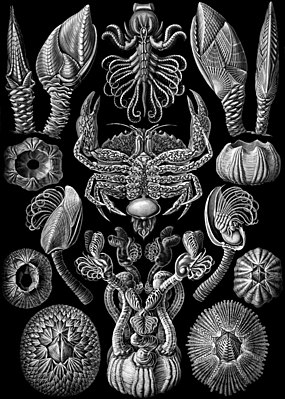Barnacles
| Cirripedia | ||||||||||
|---|---|---|---|---|---|---|---|---|---|---|

Various barnacles. From Ernst Haeckel's work “ Art Forms of Nature ” from 1904. In the middle a sack crab from the Sacculina genus . |
||||||||||
| Systematics | ||||||||||
|
||||||||||
| Scientific name | ||||||||||
| Cirripedia | ||||||||||
| Burmeister , 1834 |
The barnacles (Cirripedia) are a subclass of the crustaceans (Crustacea). A total of around 800 species are known, all of which are marine . Adult animals live sessile in or near water or parasitically on other animals.
features
Barnacles have no limbs, the abdomen is reduced, the body is short and stocky. The thorax originally consisted of six segments, each with a split bone pair . The split legs , which are made of bristle limbs (cirrus), are unsuitable for locomotion. In parasitic animals, these are completely regressed. The body is enclosed by a carapace or mantle consisting of two parts . In sessile forms of life, typical limestone plates form, which can form a solid outer casing (wall crown).
Reproduction
Barnacles are usually bisexual ( hermaphrodites ). In separate-sex species, the males are extremely small ( dwarf males ) and are located on the carapace of the female.
A nauplius larva develops from the egg and spends the first time in the female's carapace . After some time, the larva leaves the carapace in the next larval stage (Metanauplius) and continues to develop into cypris larvae . This bears astonishing resemblance to the mussel cancer . In order to fully develop into an adult animal, the cypris larva attaches itself to a solid surface with the forehead.
Food
In Portugal and parts of Spain the barnacles ( Pollicipes pollicipes ) are considered a delicacy. The animals sold there under the name percebes are popular with gourmets as a rather expensive specialty.
Systematics
- Superorder Acrothoracica
- Order Cryptophialida
- Order Lithoglyptida
- Superordinate root cancers (Rhizocephala)
- Order Akentrogonida
- Order Kentrogonida
- Superorder Thoracica
- Order Cyprilepadiformes
- Order Ibliformes
- Order Lepadiformes
- Subordination barnacles (Lepadomorpha)
- Order scalpeliformes
- order Sessilia
- Superorder barnacles (Balanomorpha)
History
Charles Darwin carried out studies on barnacles for several years before writing his major work On the Origin of Species . He used them as a model group for the emergence of species from other species through evolution .
literature
- Friedrich W. Stöcker (Hrsg.): Fachlexikon ABC Biologie. An alphabetical reference work for scientists and nature lovers. 6th, revised and expanded edition. Harri Deutsch, Thun et al. 1986, ISBN 3-87144-883-4 .
- C. Schmalz: Cirripedia - Systematic Conchylia Cabinet. Verlag Bauer & Raspe, Nuremberg 1906, OCLC 246583014 .
-
Charles Darwin : Living Cirripedia . 2 volumes, The Ray Society, London 1852–1854
- Living Cirripedia, A monograph on the sub-class Cirripedia, with figures of all the species. The Lepadidae; or, pedunculated cirripedes . London: The Ray Society 1852; digitized version
- Living Cirripedia, The Balanidae, (or sessile cirripedes); the Verrucidae . The Ray Society, London 1854; digitized version
- Charles Darwin: Fossil Cirripedia of Great Britain . 2 volumes, Palaeontographical Society, London 1851–1855
- Fossil Cirripedia of Great Britain: A monograph on the fossil Lepadidae, or pedunculated cirripedes of Great Britain . London: Palaeontographical Society 1851; digitized version
- A monograph on the fossil Balanidae and Verrucidae of Great Britain . Palaeontographical Society, London 1855; digitized version
Web links
- Cirripedia. In: W. Appeltans, P. Bouchet, GA Boxshall, C. De Broyer, NJ de Voogd, DP Gordon, BW Hoeksema, T. Horton, M. Kennedy, J. Mees, GCB Poore, G. Read, S. Stöhr , TC Walter, MJ Costello (Eds.): World Register of Marine Species. 2012.
Individual evidence
- ↑ John Francis Thackeray : Human evolution from an African perspective, with reference to Charles Darwin, palaeoclimate and the problem of defining a species. Amsterdam Archeological Center van de Universiteit van Amsterdam. J. Enschede, Amsterdam 2013.
